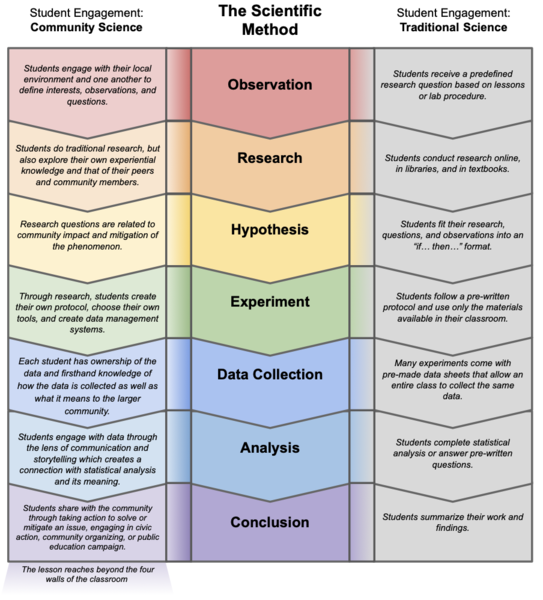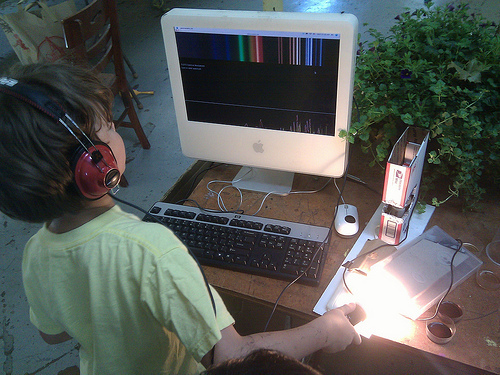#Welcome On this page you will find programming, activities, and resources related to formal and informal education. From here, you can: Join the conversation Learn how to integrate community science practices into your classroom Browse community science lesson plans from the Public Lab team Find activities for your classroom from the community Ask a question, answer a question, or follow future questions on education ## What Does Community Science Look Like in Your Classroom? Public Lab defines community science as community-led scientific exploration and investigation to address community-defined questions, allowing for engagement in the entirety of the scientific process. Unlike traditional citizen science, Public Lab’s approach emphasizes local and traditional knowledge, community ownership of research, and working together in scalable networks to encourage collaborative learning and civic engagement. [](/i/43663?s=o) Classroom community science projects are youth-led with an approach that emphasizes participant and community ownership of research, from question identification through analysis, and working together to encourage collaborative learning and civic engagement. After identifying their interests, students conduct research as they join the efforts of people and organizations already working on these issues and take the lead in aspects of study design, data collection, and analysis. The data collected from these student-designed projects supports community action and civic engagement. [Read more about integrating community science methodologies into your classroom here](https://publiclab.org/notes/mimiss/04-16-2021/community-science-in-the-classroom). **** ## How Can You Get Involved? We're looking to build a strong community of practice where educators of all experiences can share resources, knowledge, and lend a hand. Here are some ways that you can help build Public Lab's educational community ### Join the Conversation Get notified about new #education posts by subscribing to related tags. Click the button below, and subscribe to tags like "education", "classroom", "lesson", as well as other topics that you're interested in. Subscribe ### Try These Lessons in Your Classroom and Share Your Experience After using one of these activities in person, let us know how it goes in the comments. We appreciate your feedback and encourage you to share how you modify the lesson to better fit your classroom. - [Classroom Community Science](https://publiclab.org/wiki/student-led-community-science-in-the-classroom-a-curriculum): An adaptable curricula for bringing student-led environmental projects into your classroom. - [Messages from the Mississippi](https://publiclab.org/wiki/messages-from-the-mississippi-lesson-plans): A 6-part series investigating microplastics in local bodies of water culminating in student artwork and advocacy. - [Wetlands Remote Sensing & Management](https://publiclab.org/wiki/wetlands-lesson-plans): Hands on lesson plans to introduce students in grades 8-12 to oil spill cleanup, monitoring wetlands, and managing natural resources. - [Air Quality Class](https://publiclab.org/wiki/air-quality-class): An 8-week program in which students work with air quality sensors to monitor indoor air pollutants. Participants catalog and analyze the environmental air pollutant hazards that affect neighborhood homes and will share their findings with other community members ________________ ## Activities Here are some different activities particularly suited for use in the classroom: [activities:education] **** ## Questions [questions:education] **** ## Resources To learn more about the methods, successes, and challenges in developing these programs, check out our reports and evaluations from these funded projects: 2021 National Academy of Sciences Project Evaluation: Community Science in the Classroom 2022 EPA Impact Report: Messages from the Mississippi 2022 EPA Environmental Education Evaluation: Messages from the Mississippi **For more information on funding resources for educators, [click here](http://publiclab.org/wiki/funding-sources-for-science-teachers) ** [](/i/47464?s=o)...
| Author | Comment | Last activity | Moderation | ||
|---|---|---|---|---|---|
| madison124tc | " Microplastic.pptx Ms. Joseph 1st Block Class " | Read more » | almost 3 years ago | |||
| rs2009654 | " Message_From_The_Mississippi.pptx " | Read more » | almost 3 years ago | |||
| vscott2731 | " Microplastics_Powerpoint.pptx Victoria S., Kaylie F., & Chandler L. - Mrs. Desra Joseph's Class " | Read more » | almost 3 years ago | |||
| chall0105 | "Microplastics are extremely small particles of plastic waste that can come from plastic waste that has eroded into smaller pieces, or pieces of pla..." | Read more » | almost 3 years ago | |||
| adison1cooper | "What is microplastic pollution and where does it come from? Microplastic pollution is the abundance of tiny plastic particles that are the result o..." | Read more » | almost 3 years ago | |||
| JoshuaArgueta | "Our goal is to collect microplastics from the Mississippi river. We had to build a device called a babylegs, that's main job is to collect micropl..." | Read more » | almost 3 years ago | |||
| george8009740 | "The babylegs project is mainly focused on successfully collecting microplastic out any body of water. The purpose of building this is to help make ..." | Read more » | almost 3 years ago | |||
| lizzz | "Microplastics can carry disease-causing organisms. It can affect life and soil. Microplastics are tiny pieces of plastic as a consequence of plasti..." | Read more » | almost 3 years ago | |||
| J_aidaM | "Microplastics are tiny particles that were once larger plastics, but we broken down. They come from a variety of sources of plastics. They can be f..." | Read more » | almost 3 years ago | |||
| AnJah | "It is small plastic pieces less than five millimeters long and come from cigarette filters, tires, dust, personal care product, etc. Marine polluti..." | Read more » | almost 3 years ago | |||
| klanoix61 | "Our main goal is to collect micro plastics from the river. Where we had to build a device to do those things. " | Read more » | almost 3 years ago | |||
| dfolgar | "👍 " | Read more » | almost 3 years ago | |||
| carlo2005 | "This is Carlo, a STEM Magnet student studying microplastics. Microplastics absorb pollutants and carry diseases that are consumed by organisms and ..." | Read more » | almost 3 years ago | |||
| Ag8n | "The data shows that natural titration indicators with long shelf life (90 days) do exist ( see the Hippeastrum note above). However, Red cabbage d..." | Read more » | almost 3 years ago | |||
| Ag8n | "The research shows that natural titration indicators, with good shelf life, do exist ( see Hippeastrum, above). However, Red cabbage does not appe..." | Read more » | almost 3 years ago | |||
| Ag8n | "The acid (from the pH 3 solution ) for the cabbage indicator could mess up some titrations. A blank might need run(and, depending on the titration..." | Read more » | almost 3 years ago | |||
| Ag8n | "Clarification. Acidic media is pH 3. " | Read more » | almost 3 years ago | |||
| Ag8n | "Check this reference: "Evaluation of red cabbage dye as a potential natural color for pharmaceutical use" by Neela Chigurupati, et. al. Industrial..." | Read more » | almost 3 years ago | |||
| Ag8n | "Some natural indicators can have shelf lives of up to 90 days in solution. See "Hippeastrum hybridum anthrocyanin indicators of acid - base titrat..." | Read more » | almost 3 years ago | |||
| Ag8n | "Interesting paper on this same subject. " Application of Butterfly Pea extract as an indicator of acid - base titrations " by Nyi Mekar Saptarini ..." | Read more » | almost 3 years ago | |||
| hunternick363 | "This is a nice and simple method of measuring the PH of a solution. I remember these kinds of experiments we used to do in science class. We have t..." | Read more » | almost 3 years ago | |||
| stevejohnson | "thanks for the information " | Read more » | almost 3 years ago | |||
| Ag8n | "For a couple other reads, look up "The Effect of pH on Color Behaviour of Brassica oleracea Anthocyanin" in Journal of Applied Sciencies, volume 11..." | Read more » | almost 3 years ago | |||
| Techhype | "Awesome https://www.naijamula.com.ng/ " | Read more » | almost 3 years ago |